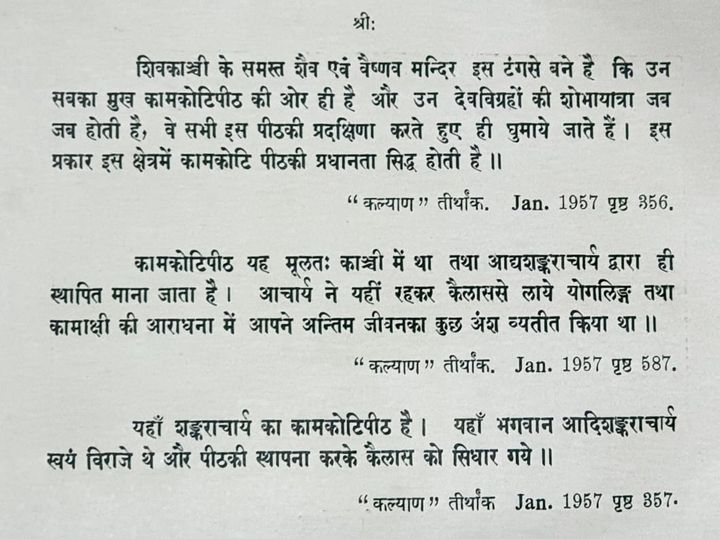-
The Hindu, 12th July,1924 : col. 5.
“The author has taken great pains to sift and test the Various dates till now in the market of Shanakra’s birth and has chosen 509 B.C. as the most likely.
We congratulate him upon having hit the right nail on the head; it will please him to know that the ancient Tibetian records support him. For Shankara came in just 57 years and 9 months after the Nirvana of Buddha. He need not have wavered in his decision and put forth an alternative date of 44 B.C. of the Sringeri matha.
The life account of Shankara contains nothing new; and the author might have thrown overboard much of the heavy useless ballast of the various Shankara Vijayas and sail his craft lightly…………. The works now current might more properly be from the pen of the “Abinava Shankara of the Eight Century.”
-
Upanishad Brahmendra Matha … 1
Upanishad Brahmendra Matha is situated in Kanchipuram. Upanishad Brahmendra Sarasvati was a disciple of one Sri Vasudevendra Sarasvati. He was also known as Sri Ramachandrendra Sarasvati.
Upanishad Brahmenrda wrote commentaries on all the 108 Upanishads. He seems to have lived during the 18th century. At the end of the commentary on the Muktikopanishad, he says, he completed it on 17-12-1751. His writings come to about 45,000 granthas. His contributions to Advaita is voluminous.
In Benares there is a Sankarite institution called Brahmendra Matha in the Shivala Ghat. There is an inscription dated Vikrama Samvat 1941 Salivahana Saka 1806 (1884 C. E.) which refers to Sankaracharya, indicating thereby that a parampara of Sri Sankaracharya with “Indrapatta” existed in the 19th century at Benares. Visvanatha yatindra who is referred to in this inscription was a disciple of Sri Chandrasekharendra Sarasvati, the 64th Acharya Kanchi Kamakoti Matha.
There is a tradition in Benares that a sanyasi belonging to this Matha once visited Benares. At that time the Maharaja of Benares was suffering from some disease. The Sanyasi cured him of this disease. The Maharaja wanted to do something in acknowledgement of this help.
The Sanyasi wanted that a Matha may be constructed in Kasi for his stay. The Maharaja gave the necessary land for the Matha and the Matha was constructed, funds being given from the original Upanishad Brahmendra Matha. That is the Matha, now known as the Brahmendra Matha in Kasi.
Vasudeva Brahmendra Sarasvati of Upanishad Brahmendra Matha was the author of “Sastra Siddanta Lesa Tatparya Sangraha “.
According to the introduction to this book published in 1926 written by one Mayavaram Vaidyanatha Sastri, this Vasudeva Brahmendra Sarasvati was a disciple of one Krishnanandendra Sarasvati who was himself a disciple of Upanishad Brahmendra Sarasvati.
Ramabrahmendra, disciple of Svayamprakasendra Saraswati lived in Benares. He was the author of the work Ramabrahmendra Pancadashi.
Ramabrahmendra Panchadashi is a collection of various works compiled by Ramabrahmendra which includes Mathamnaya from Citsukhacarya’s Brihat Sankaravijaya, Sureswaracarya Sishya Parampara Stuti and Sri Kanchi Kamakoti Guruparamapara namamala, stava which was published by Kalpattu Guruswamy Sastry, in 1894.
In the introductory part of the above cited publication, it is mentioned that this had been regularly recited by the Sanyasi disciples of Kashi and the same was obtained from one Paramanandendra, who was residing in the Dandi Ghatta of Avimukta Kshetra (Kashi).
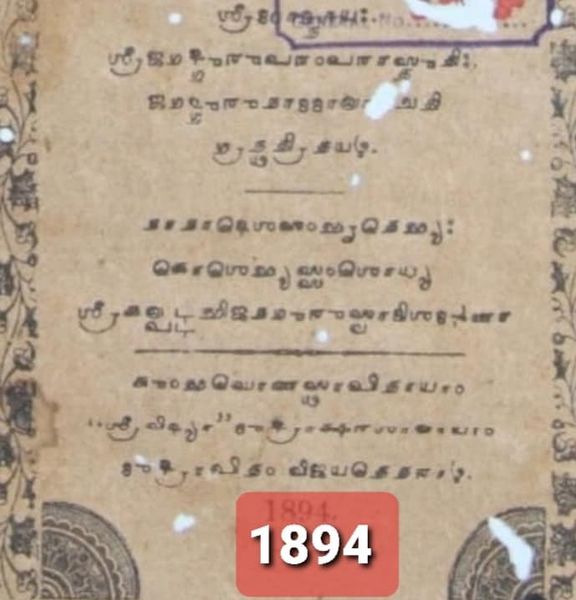

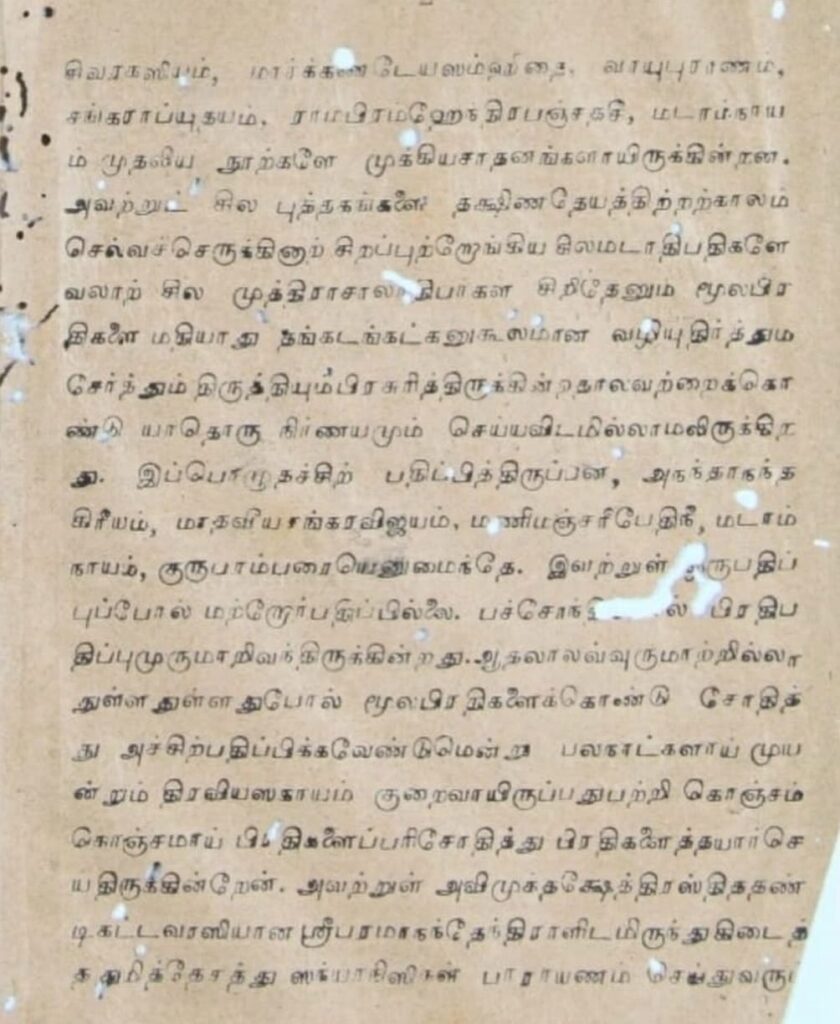
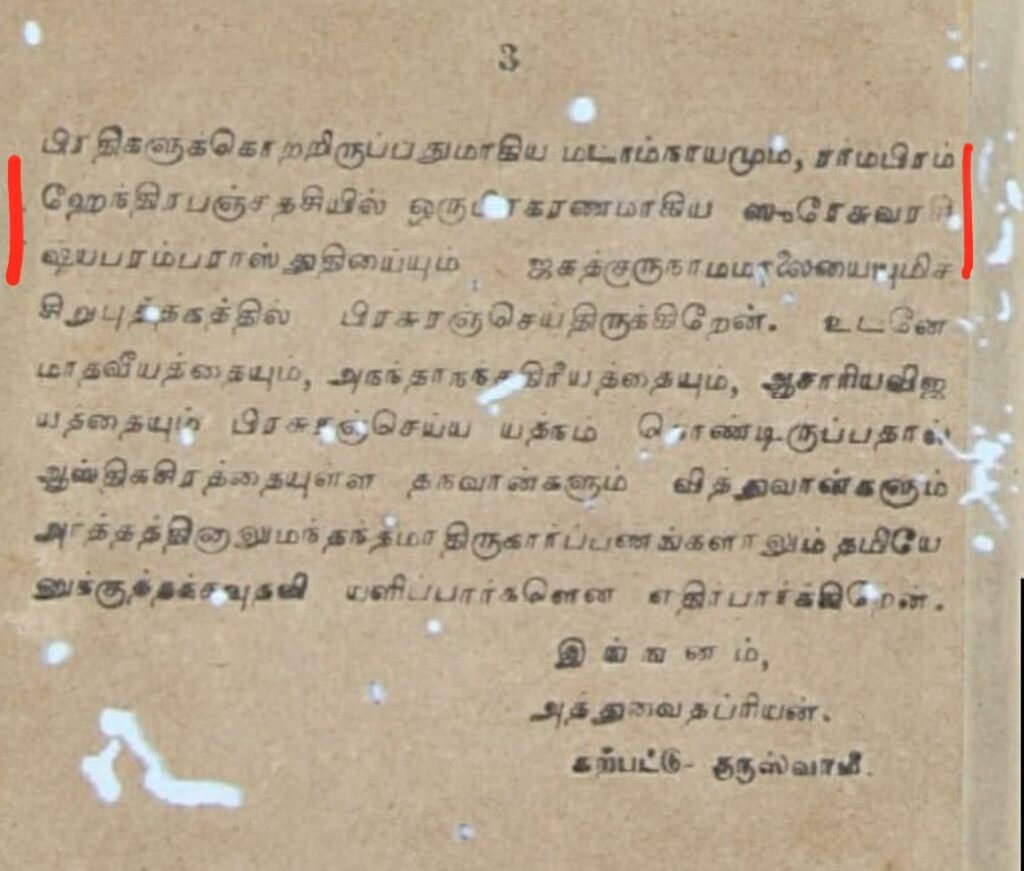

-
His Holiness Sri Subrahmanya Abhinava Saccidananda Bharati Swami, 39th Peethadhipati of Sringeri Sivaganga Matha (1886-)
(A Short History of The Sivaganga Mutt By B.Suryanarain Row, Thampy&Co., Bangalore, 1914)

-
Pushpagiri Matha
According to Gururatnamalika of Sadasiva Brahmendra (verse no.75) and the Sushama commentary on the same by Atmabodha, Vidyaranya, the disciple of Vidyatirtha, Peethadhipathi of the Kanchi Kamakoti Peeta – went to Mysore which was then in a state of confusion, established 8 branch mathas there, Virupaksha and Pushpagiri being two among them.
As regards these two mathas, Kokkandram Venkataratnam Pantulu, an adherent of Sringeri Matha in his Sankara Matha -Tatva- Prakasikartha-Sangraha quotes from the Mathamnaya recited in Pushpagiri Matha according to which Sri Vidyaranya went from Kanchi and installed Chandrasekhara Bharati at Sringeri. He also established a new Matha at Virupaksha where he installed Narasimha Bharati as the Head.
Another version about the origin of this Sankarite institution is as given below:
One of the successors of Narasimha Bharati in the Virupaksha Matha went on tour and on his way he reached Pushpagiri. He found that it was a convenient place for tapas and meditation and accordingly founded a matha there and himself stayed in that (Pushpagiri) Matha and sent one of his disciples to preside over the Virupaksha Matha.
In the Topographical list of inscriptions of the Madras Presidency, many records with names of Narasimha Bharati and Vidyasankara Bharati, the Gurus of Pushpagiri matha, are found. All these Grant’s were made to the Pushpagiri matha, only as an * independent religious institution* .
None of these records mention this matha as a shakha or branch matha of any other Sankarite institution.
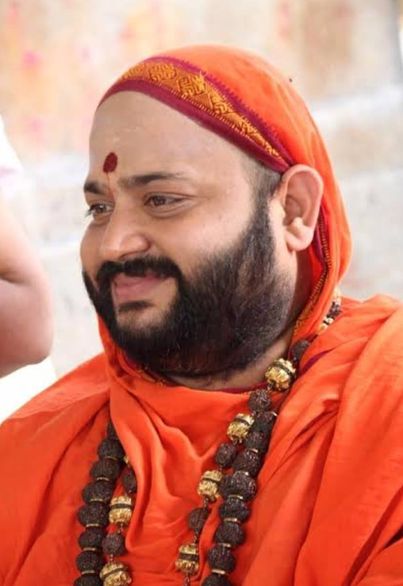
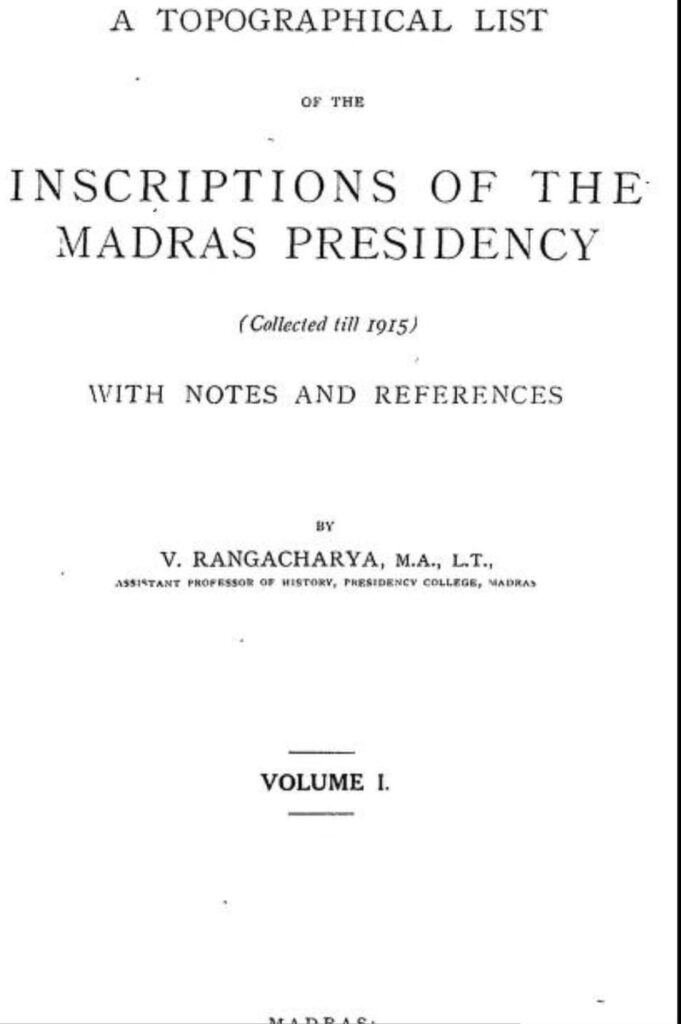
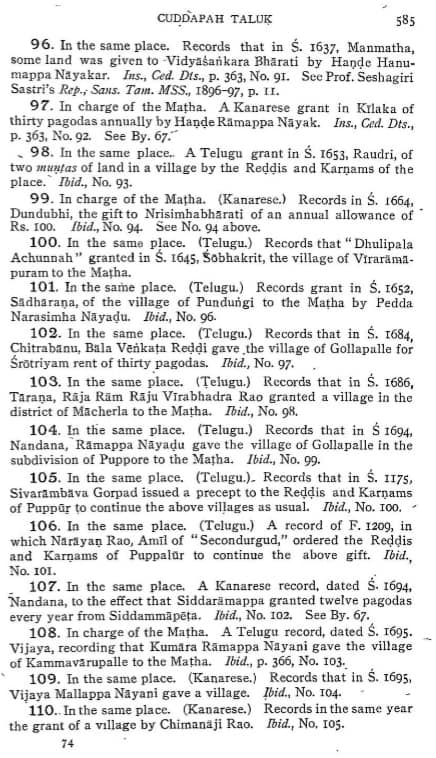
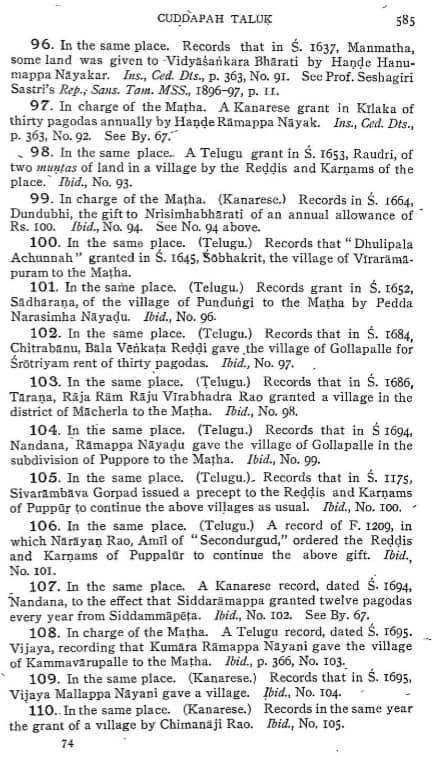
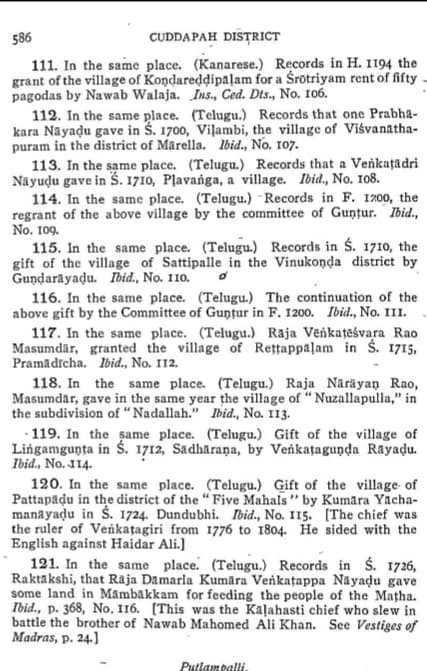
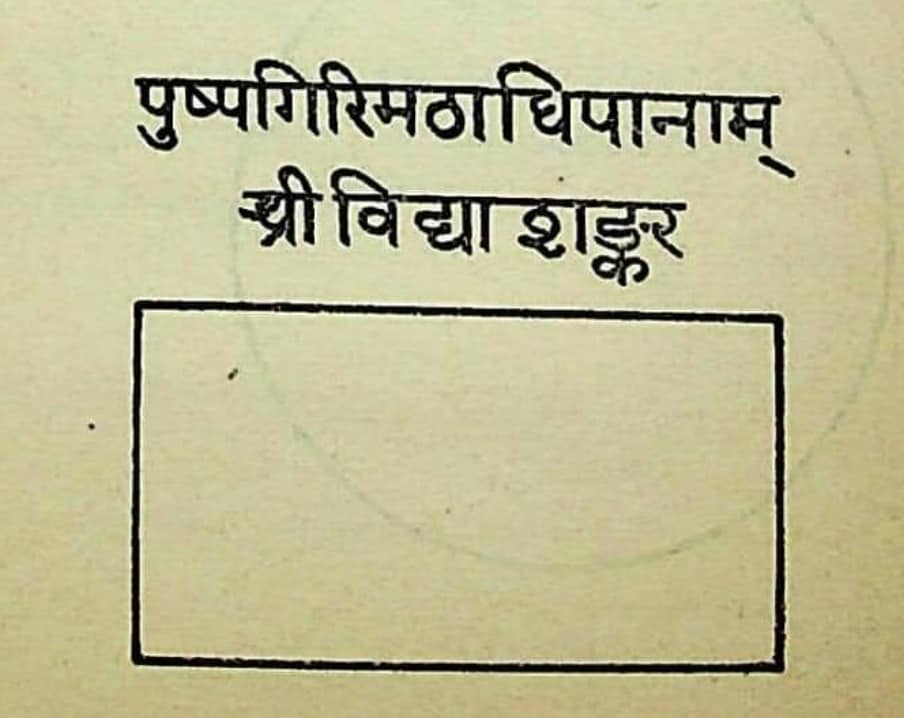
-
Dakshinamurti Mutt, Benares (1974)
In the cultural heritage of India two streams viz, Pravirtti and Nivritti based on the Vedas are flowing. For these two streams the original canal is Lord Siva in the form of Uma and Mahesvara. This form indicates the path or Pravirtti. For the path of Nivritti the form of Dakshinamurthy is the original source. In Northern India, when many temples were razed to the ground, during the Mughal period, the tradition of Dakshinamurthy came to fade.
From Bengal to Baluchi and Kashmir to Kerala, the upasana of Dakshinamurthy is observed to this day. Yet the scarcity of temples for external worship of Dakshinamurthy are very few.
His Holiness Satchidanandagiri has constructed a temple of Dakshinamurthy near the old temple of Siddhantha Mani where he himself meditated upon Dakshinamurthy. Probably this is the Advaita Mutt referred to as Dakshinamurthy Mutt, at Kasi.
The Guruparampara of Dakshinamurthy Mutt also called Dhruvesvara Mutt, Varanasi is as follows:
1. Managiri
2. Meghagiri
3. Ramagiri
4. Satchidanandagiri
5. Amarendragiri
6. Manishagiri
7. Ramananda Giri
8. Nrisimha Giri
9. Niranjana Giri
10. Krishnananda Giri
(Prepared from ‘Gandivam’-Chaitra Sukla Prathama, 24-3-1974 By Sri Anantananendra Saraswati)
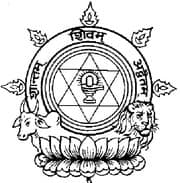

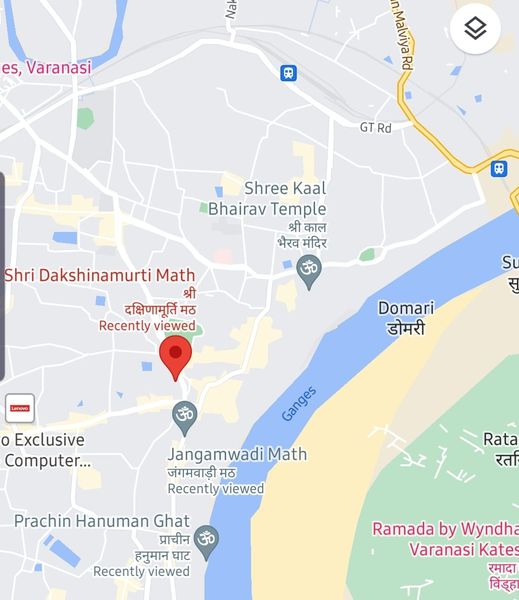
-
गद्यवल्लरी Gadyavallari – Guruparampara List
This work has 2016 slokas in Nagara character which contain Tantric rituals for the worship of various forms of S’akti.
Gadyavallari was written by Nijátmá – prakás’ánandanátha Mallikárjuna Yogíndra in the18th century. A paper manuscript of this work was ccollected from Bihar State.
A brief reference about this Tantrik work is also found in the Notices of Sanskrit Manuscripts by R. L. Mitra, No. 2261, published by the orders of the Government of Bengal, Vol.VIzi, Calcutta, 1884.
This work opens with a list of the Gurus belonging to the S’añkarácharya Parampara. After naming some of the earliest Preceptors of Advaita such as S’iva, Vishņu, Vas’ishtha, Parásara, &c., the line of succession from S’añkaracharya runs thus:
1, Sankara;
2, Bodhaghana Achárya;
3, Jnánaghana;
4, Jnánottamas’iva;
5, Jnánagiri;
6, Simhagiri;
7, I’s’vara Tírtha;
8, Nrisimha Tirtha;
9, Vidyátirthas’íva;
10, Bharati Tirtha;
11, Vidyáranyaguru;
12, Malayánandadeva Tirtha Saraswatí;
13, Yádavendra Saraswatí;
14, …… sarasvati;
15, Srínrisimha Saraswatí;
16, Mádhavendra Saraswatí;
17, Mallikarjuna Yogindra;
18, Rámadeva;
19, Dáyadeva Yati;
20, Gananánanda;
21, Chidghanánanda;
22, A’nanda-chitpratibimba.
The succession list of Gurus of the Sringeri Matha given in the Guruvamsa Kávya of the Sringeri matha substantially agrees with that given in Gadyavallari written in 1435 Saka.. 1736 C.E. (upto Vidyaranya). It is to be noted that the names of Gurus starting from Malayananda Deva (Sringin or Malayala Brahmendra?) are not found in the recently published list of Gurus of the Matha.

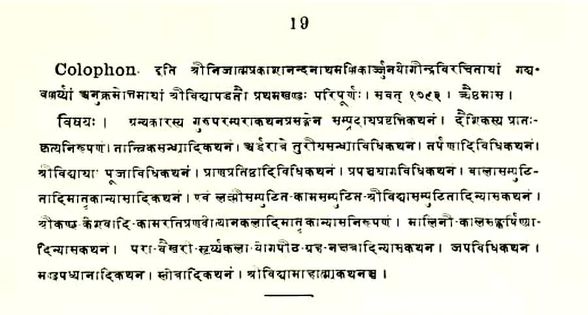
-
काशी ब्रह्मेन्द्र मठ – शिलाशासन
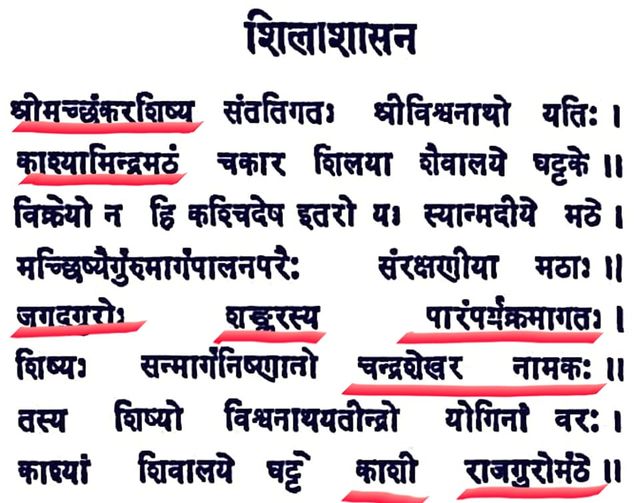
-
SRI KANCHI KAMAKOTI PEETAM SRI ADI SHANKARA BHAGAVATPADA KEERTI STHAMBHAM, KALADY, KERALA


-
SRI KANCHI KAMAKOTI PEETAM SRI SANKARA BHAGAVATPADA KEERTI STHAMBHAM, KALADY, KERALA
SRI KANCHI KAMAKOTI PEETAM SRI SANKARA BHAGAVATPADA KEERTI STHAMBHAM, KALADY, KERALA
The tallest religious monument of Kerala, the Sri Adi Sankara Bhagavadpada Keerti Sthambham , rising to a dizzy height of 152 feet to perpetuate the memory of the Saint, who was born at Kaladi to rise to the pinnacle of glory and to place the resuscitated Hinduism on its solid pedestal, overlooks the sacred spots of the village, associated with Sri Adi Sankaracharya’s life.
From the top of the nine-storey structure an imposing eight-foot statue of the Saint with his four disciples looks down on the sprawling carpet of green beneath, the shadowy valleys of Ghats merging with the margins of the distant horizon and the proud Periyar river still washing the feet of the village with the brimming irrigation canals, criss-crossing the countryside to bring life to the parched land.
The exquisitely built reinforced concrete structure represents a harmonious blending of the concepts of modern architecture with the prescription of the scriptures and traditions and the stipulations of Silpasastra.
The temple architecture traditions of Kerala and Tamil Nadu have also been blended judiciously. The seasoned masons of Kerala and a good number of young workers, men and women, worked with fervour for about two years to give concrete shape to the tower, while the deft hands of the artists from Tamil Nadu drew poems on Sri Sankarachaya’s life in cement for the ornamental work.
Though originally conceived to be 85 feet tall, which incidentally coincided with the 85th year of the Jagadguru of Kanchi Kamakoti Mutt, His Holiness Sri Chandrasekharendra Saraswathi Sankaracharya Swamigal, the architectural and engineering require ments and the aesthetic compulsions finally raised it to over 150 feet, more than double the 60 feet diameter of the basement.
Among the latest in the series of Sri Sankaracharya monuments built under the auspices of the Kanchi Mutt in different parts of India and Nepal, the Kaladi tower costing Rs. 20 lakhs, is one of the tallest so far. The other memorials are at Kanchipuram, Kurukshetra, Haridwar, Puri, Madhyarjunam, Jambukeswaram, Rameswaram, Kanyakumari, Srisailam, Tirupati, Tryambaka, Lakshmanjhula, Badari, Kedara, Khatmandu, Prayaga and Kashi.
Though it can still be called a religious monument, the concept and the execution of the Kaladi tower are essentially secular. Basically, it is only a memorial dedicated to the greatest son Kerala has ever produced. There is nothing of a temple or place of worship in the stupa.
The life story of Sri Sankaracharya and the huge figures of Gods and Goddesses installed on the different floors may still make it look like a temple. But the difference is brought home by the fact that the figures and relief work were all done in cement as distinct from granite, the usual medium for the temples.
It is just another instance of the harmony -a secularist memorial to a religious genius, to whom the country owes a good deal. Its utility too can be very secularist in nature, for it can be developed into a centre of Vedic learning, a place of tourist attraction, a deserving monument to an epoch in history, when the genius of India found expression. A small shrine built beside the stupa could grow into a focus of religious worship.
The marvel of the Saint’s life starts strik ing the visitor as soon as he steps on to the basement of the tower where the ‘Padma paduka’ in marble is installed. Then as you ascend the winding stairs the story of the genius and his ascension to the pinnacle unfolds itself before you in the form of 49 panels of mural relief.
The flight of steps lead you to a lofty world, far above and away from the base to the Sankarapattabhisheka and finally to the imposing figures of the Saint and his disciples, overlooking the world beneath, with Dakshinamurthi in the background as mural relief.
As you go past the floors, the huge figures of the ‘Gitopadesa’, Vinayaka, Muruga, Surya, Mahavishnu, Kamakshi and the colossal Sivalinga, make your climb a pilgrimage, a spiritual and an aesthetic experience. And you never realize that you have climbed 150 feet.
Jagadguru Sri Jayendra Saraswathi Sankaracharya Swamigal of Sri Kanchi Kamakoti Peetam arrived at Kaladi on May 6, 1978, and stayed there till May 18, in connection with the Samprokshanam of the Stupa, which took place on May 12 (Sri Sankara Jayanthi Day).
Sri Sankaracharya stayed at the Manikkamangalam Devi Temple, where the father of Sri Adi Sankara was the chief priest, and performed Sri Sankara Jayanthi Celebrations.
– P. Aravindakshan (1979)

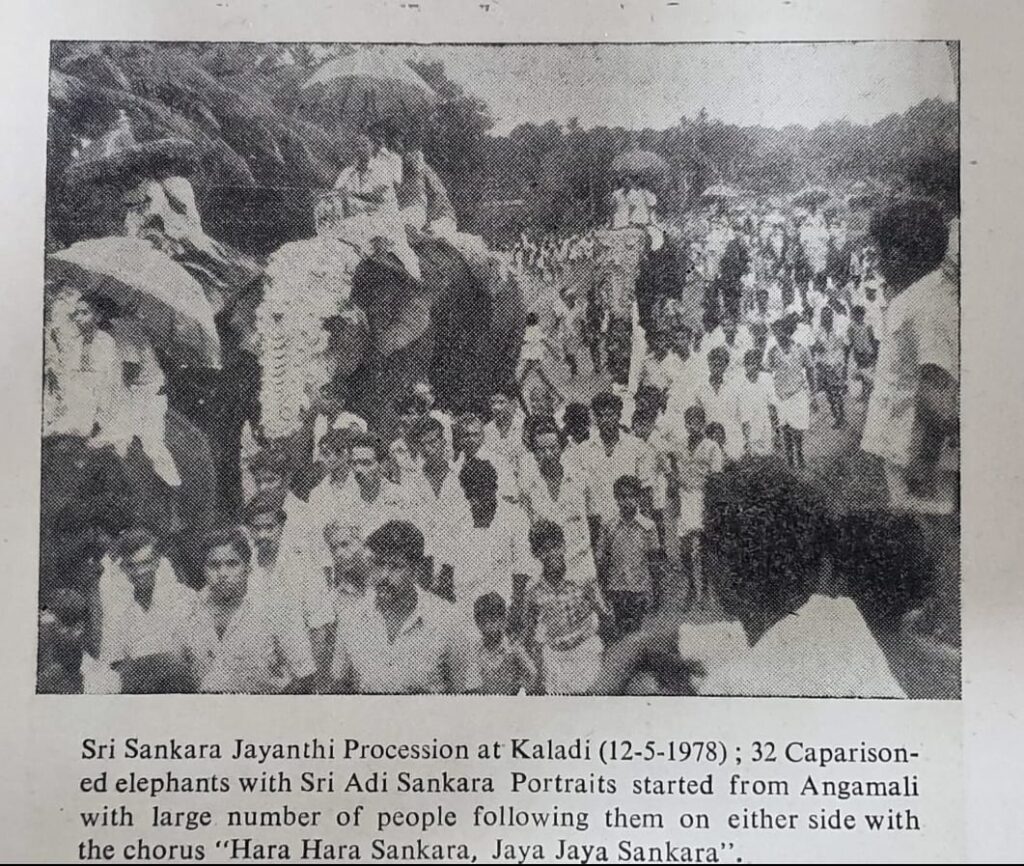
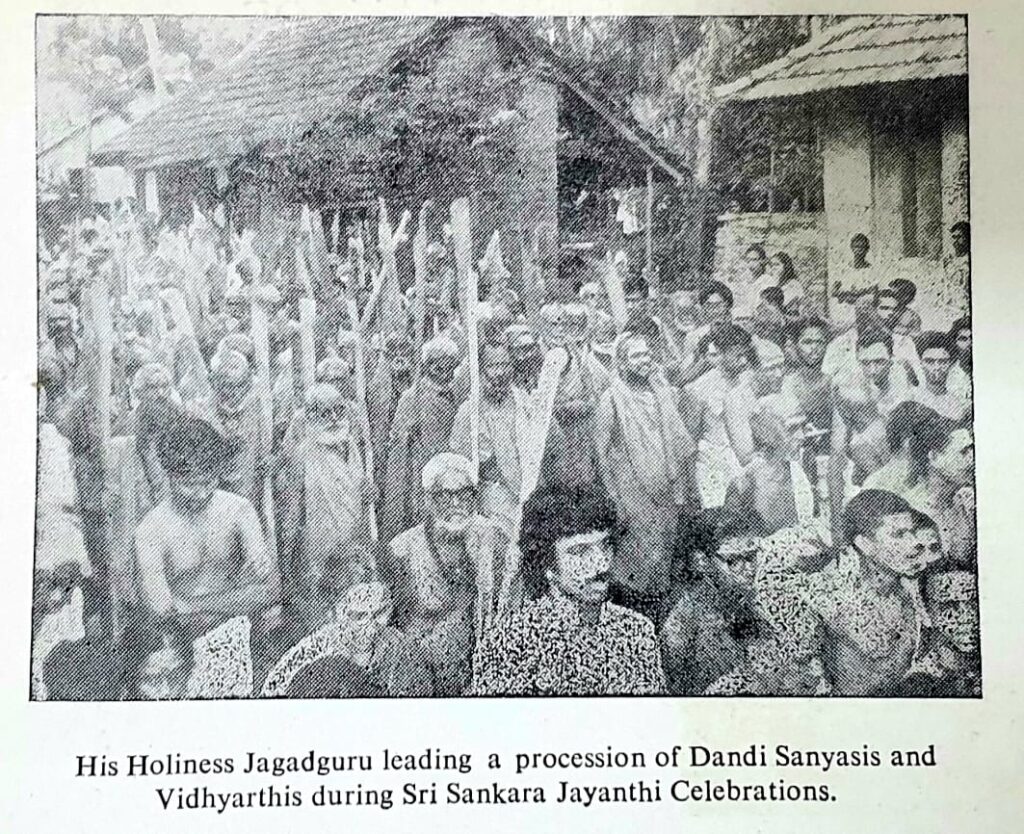
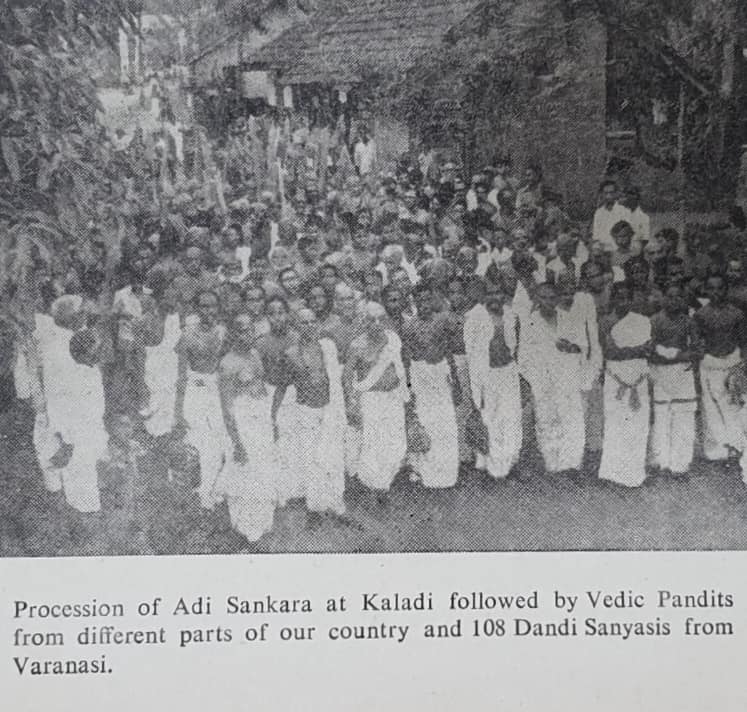
-
‘Kalyan” pilgrimage (Jan. 1957)
